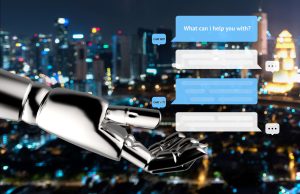Digital Reinvention
Chatbots – A new opportunity
January 9, 2019 | Written by: Salil Ahuja
Categorized: Digital Reinvention
Share this post:

As each new year begins, so do a flurry of articles predicting trends and technologies for the year. I recently read articles on the state of affairs for chatbots and trends in 2018. What is really starting to excite me is what the magazines and blogs are not talking about. Most of the discussions on chatbots today are focused on enhanced user experiences, 24X7 availability, consistency in responses, savings, etc. While they are true, to me they do not reflect the whole story. The opportunity I see in customer success is far more interesting and exciting.
Chatbots as defined in the Oxford Dictionary – “A computer program designed to simulate a conversation with human users, especially over the Internet.” With the use of artificial intelligence technologies like natural language processing (NLP) and machine learning, these chatbots are beginning to generate an understanding of every customer query and interaction and other metadata beyond just the conversation like uncovering sentiment and other insights. The advantage that technology has over human is scale. Hence, a massively scaled approach to truly understanding the customer, their sentiments, their feedbacks, their likes, and dislikes. These insights are being made possible thanks to chatbots. That is the bigger picture, which really excites me. When customer interactions, customer feedback, and customer sentiment are not separate use cases and initiatives but by-products of the same interaction, customer engagement will truly begin to transform. The interaction itself will generate enough metadata that no surveys will be needed. Real issues and brilliant suggestions don’t get lost in hard drives and data stores.
The first chatbot was called ELIZA. Developed in 1966, the program was created by Joseph Weizenbaum at MIT. It essentially recognized keywords and phrases and provided responses based on that. At the time it is really awesome, however, it was hard to adopt it for open interactions and enterprise use. The reason was essentially the inconsistency and complexity in the vernacular used by humans to articulate statements. It appeared an impossible task to make rules for each possible combination of words.
That has changed with advancements in natural language processing and machine learning technologies. NLP is a branch of computer science and specifically artificial intelligence that enables interaction between computers and human (natural) languages. Advancing maturity of NLP capabilities are starting revolutionizes many industries. One, in particular, is customer service or customer engagement. If you are in the business of customers and customers experience, you have probably heard a lot of chatter about chatbots or virtual agents. With advancements in Natural Language Processing, machine learning and other related artificial intelligence technologies automated interaction capabilities are promising to provide transformative self-service experiences. These systems learn by example and provide relevancy scores to help articulate their understanding of the customer inquiries. Hence enabling customers to ask the same questions in many different ways, while still understanding the customer’s intent and related context.
Dare I say the days of Net Promoter Score (NPS) are numbered or at least it is time to rethink such statistics. NPS is the industry standard for customer satisfaction. But does it really serve that purpose? NPS requires the customer to provide feedback and by its very nature gets skewed to responses received. If, for example, only 10% of the customer’s reply then that’s what the NPS will represent. Industry averages are between 10% to 30% ( https://www.referralsaasquatch.com/net-promoter-score/ ). However, every customer that engages in the digital and /or social channels builds a significant footprint with enterprises. This will now be further enhanced with an onset of chatbots.
As this technology advances it will start to implicitly catalog deeper insights on every transaction with customers. This makes customers feedback /insights /sentiments and all related activities second nature to the transaction and not a secondary activity. Today we think of chatbots as transforming the customer experience. Tomorrow, chatbots will enable the transformation of customer insights, retention and understanding for companies. The same chatbots can also be the first point of contact across multiple channels like voice, web and social. As NLP and machine learning-based chatbots like Watson understand and respond to customer interactions, the technology also identifies all the topics the customer is interested in, the emotional journey of each conversation (did it start positive and go negative?), potential retention issue, and more. The list goes on and is hard to completely imagine the full potential.
Do you see the transformation and alignment? Are there other industries you are seeing similar changes? Do leave a comment …
Logistics Operations Management ERP on AWS Cloud
Logistics operations is an essential part of the supply chain and refers to the process of moving finished goods, starting from the manufacturer, and moving to the end user.
How ICICI Prudential Life Insurance is Scaling Customer Care and Leveraging AI to Personalize Experiences
Organisations are constantly challenged to meet dynamic customer requirements and rethink ways to engage with them on their terms and as per their convenience. With customers at the core of decision making and business success, organisations are tuning to digital capabilities that can support new-age services. When done well, after sales service boosts the overall customer experience by providing […]
Genpact undergoes cyber defense transformation with IBM Security
Genpact, a global professional services firm, is accelerating digital-led innovation and digitally-enabled intelligent operations for its clients – many of them Global Fortune 500 companies – to deliver real-world transformation at scale. With oversees global operations in 30 countries serving over 800 clients, Genpact’s 90,000+ employees are reinventing business models and running thousands of processes, […]



